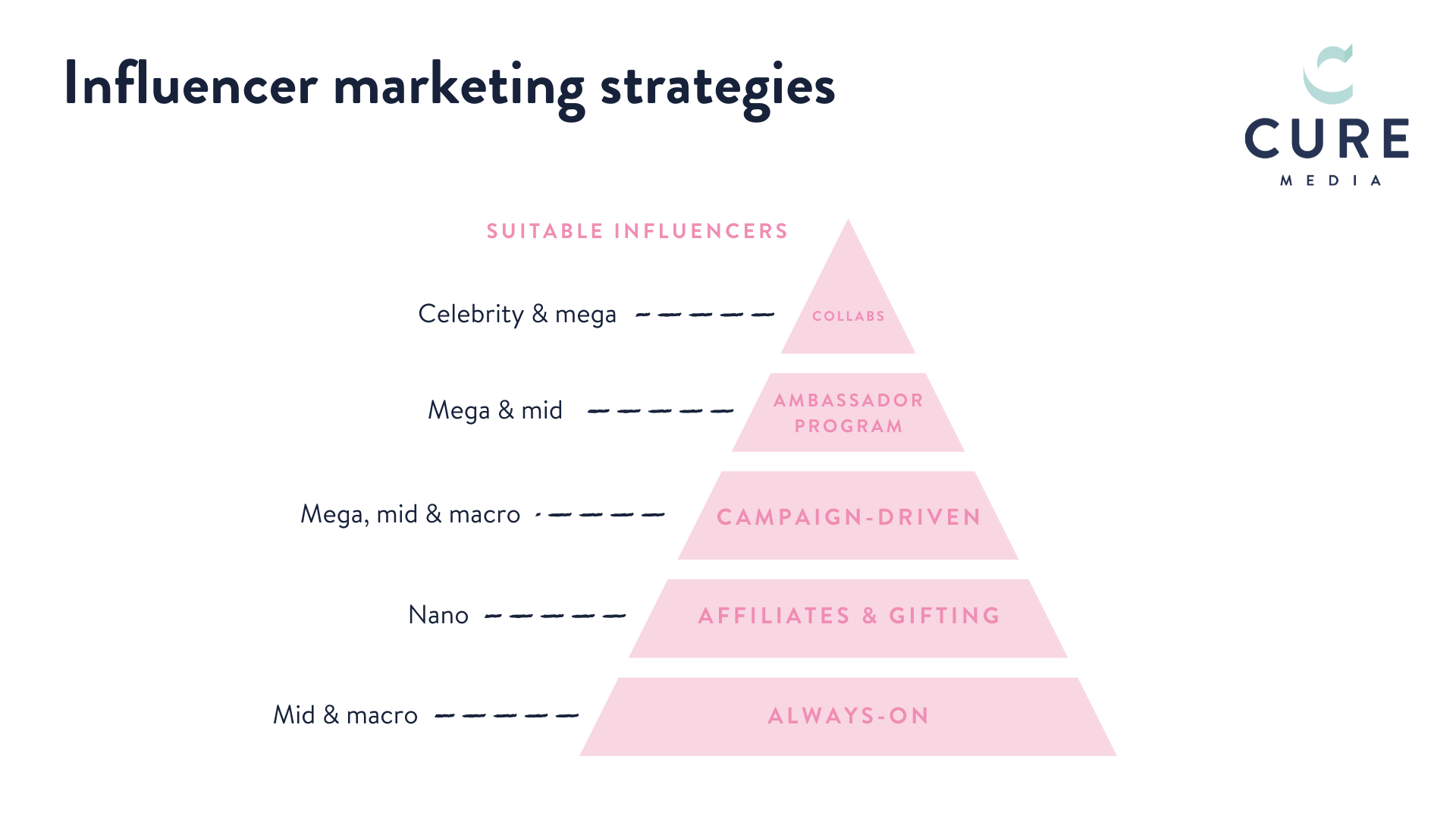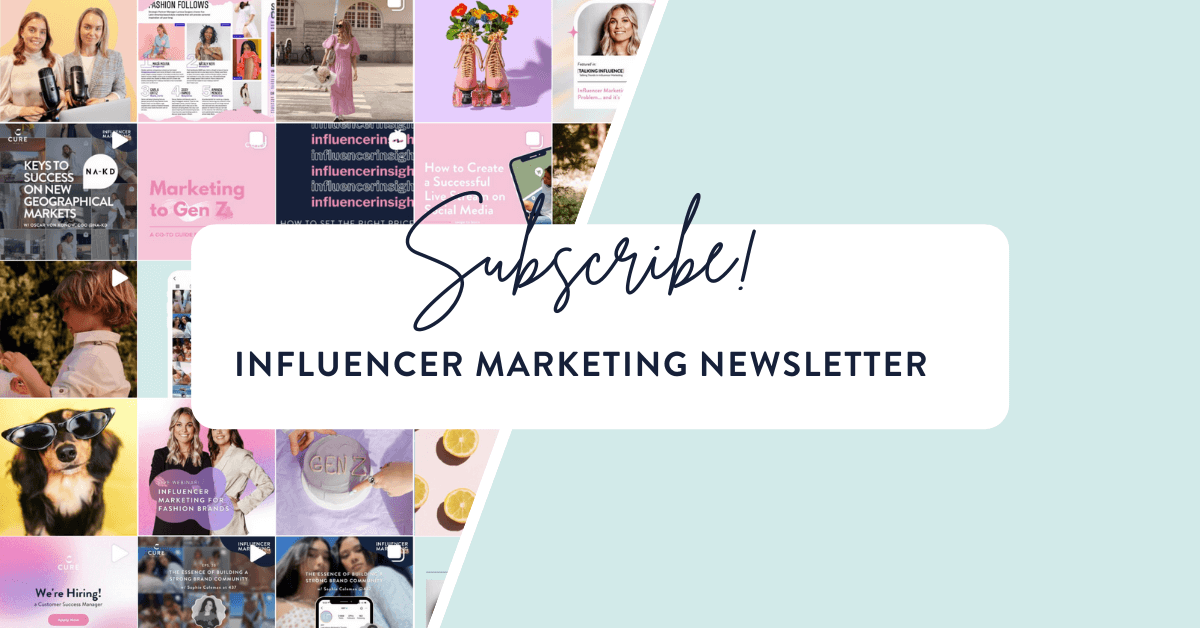Setting a clear strategy is as important for influencer marketing as it is for any other marketing channel. A strong influencer marketing strategy not only provides a clear blueprint for the channel but also ensures that you get the most out of your investment.
The influencer marketing strategy your brand uses is impacted by several factors. For example, your budget, the amount of time you can dedicate to influencer marketing, and product fit, among other things. Each strategy works best when paired with specific types of influencers. We will reference these influencer types throughout the article. You can find the parameters we use to define them below:
- Celebrity influencer: An influencer whose fame was built outside of social media
- Mega-influencer: 1 million+ followers
- Macro/ Midsize-influencer: 10k-100k followers
- Micro-influencer: 3k-10k followers
- Nano-influencer: Less than 3k followers
As we explore the five different influencer marketing strategies and their use cases, it may be helpful to think of them in the shape of a pyramid, as you see in the below graphic.

1. Collaborations
Collaborations are the tip of the iceberg when it comes to influencer marketing. This highly exclusive influencer marketing tactic refers to a joint venture between an influencer and brand, such as a new product line, in which the influencer earns a percentage of the total sales.
The most suitable influencers for this tactic are celebrities and mega- influencers with high trust and credibility in their niche. Although celebrities and mega-influencers are not always the best fit for influencer marketing, they work well for collaborations as long as they have previously worked with your brand and are genuinely engaged with the product or service. When collaborations are done right, their biggest strength is authenticity.
The downside of collaborations, however, is that it puts all of your influencer marketing eggs in one basket, both in terms of the channel’s effectiveness and the influencer’s reputation. If the influencer is caught up in a scandal or some type of bad will, it will negatively affect your brand.
The most common objective for this tactic is driving sales, with the corresponding KPI being revenue. Another common objective of a collaboration with a celebrity or mega influencer is to strengthen brand awareness and preference. In this case, the corresponding KPI would be brand surveys.
Prefer to listen? Tune in to this article as a podcast episode.
2. Ambassador programs
Brand ambassadors have exclusive, long-lasting relationships with the brands they represent. This means that the influencer will not typically engage in other brand partnerships during this time, and instead, fully dedicate themselves to being the face of the brand.
Given the high stakes nature of this partnership, brand ambassadors tend to be celebrities or mega-influencers that have a widespread influence and trustworthy reputation. A few well-known examples of brand ambassadors include George Clooney for Nespresso, Rihanna for Puma, or the star-studded “dream team” of L’Oréal global ambassadors.
Because ambassadors are not just promoting your products, but standing in for your brand, it is important to take extensive measures when selecting which influencers to work with. Brand ambassadors must have the same values as your company, excellent media training, and generally, as few risks as possible so that your company’s reputation is not compromised. The longer you work with a brand ambassador, the more people will associate them with your brand, so it is vital that these associations are positive.
Due to the exclusivity and long time frame of ambassadorships, this influencer marketing tactic comes at a high cost. If this is something your brand is prepared to take on, then collaborating with brand ambassadors can be a great way to increase brand awareness, promote new products, drive sales and website traffic, and access new customer bases. However, if you are looking for a more balanced influencer marketing approach, you may want to consider a different strategy.
3. Campaign-driven
Historically the most common approach to influencer marketing, you can find campaign-driven influencer marketing (also known as tactical campaigns or one-off influencer marketing) in the middle of the pyramid. This approach continues to be popular among fashion brands and can be defined as a single or short-term influencer marketing campaign focused on a specific occasion like a new product launch. Mid-size and mega influencers tend to be the go-to for this strategy, but any size influencer can work well.
The advantage of this tactic is its flexibility. Because there’s no long-term commitment between your brand and the influencers you’re working with, you can easily pause the collaboration whenever you want. This can be especially useful if the influencer you are working with turns out to be a bad brand-fit, or if you are unhappy with the direction of the campaign.
Another reason for this tactic’s popularity is its simplicity. Tactical campaigns have clear start and end dates, easy-to-define resource requirements, and easily measured outcomes. Again, this can be advantageous when focusing on a specific occasion like a new product launch, but it also limits your ability to optimise the channel as you go. For example, if you realise one platform is performing better than another or if you are unhappy with an influencer, you will have to wait to apply these learnings until you run another campaign.
One of the biggest weaknesses of one-off campaigns is that they undermine the strength of influencer marketing as a relationship-building channel. When brands use influencer marketing, they are investing in the relationships between influencers and their audiences. But, just like in real life, trust and relationships take time to build. As such, an influencer recommendation is only effective if their followers believe it is genuine. If the influencer mentions a product repeatedly in a one-month window and then never again, the authenticity is called into question.
Overall, campaign-driven influencer marketing can be a great tactic for brands looking to test out the channel or create a “big bang” around a new product launch. At the same time, however, working exclusively with one-off campaigns will make it difficult to have a lasting impression on your target audience. So, even if you see quick results from short-term campaigns, it is unlikely that you will be able to grow your results without a sustained commitment in terms of time, energy, and resources.
4. Affiliates and gifting
Next on the pyramid of influencer marketing strategies, we find affiliate marketing and gifting. Beginning with affiliate marketing, this tactic is employed when someone posts about a product on social media and earns a commission in return. Gifting, on the other hand, refers to an influencer being gifted a product by a brand in hopes that they post about it on social media.
The primary advantage of both tactics is that they are cost-effective. Firstly, neither strategy requires influencer fees. For affiliate marketing, your brand only needs to pay commission fees, and for gifting, the only cost is the products you give away. These tactics are definitely the most affordable option of the five strategies you have to choose from, as long as your product or service has a lower price point. Gifting expensive products would add up over time, and affiliate marketing depends on high conversion rates, which are difficult to achieve with pricey products.
Affiliate marketing and gifting share common disadvantages. In both cases, your brand has very little control over who is going to post, what audience you will reach, and what content will be shared. It is especially difficult to rely on gifting and affiliate marketing during popular consumer periods like Black Friday when influencers’ content schedules are likely full. For this reason, gifting works best with micro and nano influencers because they will be more likely to post about your products than a larger influencer would be. Affiliate marketing, on the other hand, works regardless of influencer size. What’s important is that the influencer has an engaged audience that trusts their recommendations. Overall, the unpredictability of these tactics means they are best used in tandem with other strategies.
5. Always-on
Brands that work with always-on influencer marketing establish a constant presence on social media via a pool of influencers that their target audience follows and trusts. The idea is to consistently appear in consumers’ feeds so that your brand is top of mind when it’s time for a purchasing decision. By adopting this strategy, brands commit to months if not years of continuous influencer activations. So, while a one-off campaign is about pushing a message, always-on influencer marketing is about becoming part of a conversation. With an always-on presence, brands become recognisable and reliable figures in their target audience’s feeds and lives.
One of the unique strengths of always-on influencer marketing is the ability to optimise and improve as you go. Without strict start and end dates, you are free to tweak and finetune the results along the way. For example, if you notice a specific influencer is not performing well, or if the messaging of the campaign is not resonating with your audience, you can make adjustments immediately. Consistently improving the details of your campaigns will eventually create your brand’s “secret sauce” for influencer marketing.
Another strength of an always-on strategy is the high level of brand awareness it generates. Today’s consumers are flooded with thousands of commercials a day, so your brand needs to be persistent and unique in its messaging to cut through the noise. Always-on influencer marketing is well suited for this because it uses a large pool of nano, micro, and midsize influencers for a long period of time. By consistently working with the same trusted influencers, you will steadily build brand awareness and preference among your target group.
The last strength of always-on is its ability to prove ROI. Considering only 30% of marketers say they can accurately collect ROI data from their influencer campaigns, this is especially useful. Always-on makes it easier to prove ROI due to the comprehensive data collection it relies on. The more data you have, the easier it is to see patterns in shopping behaviour and discern the interaction effects between channels.
To wrap-up…
Brands who enjoy the most benefits from influencer marketing tend to employ a blended strategy, maintaining an always-on approach in the background while deploying strategic campaigns to amplify specific messages like a new product line.
For example, when launching in a new market, it may be advantageous to start with a bang by collaborating with celebrity influencers. However, to build credibility and awareness in the long run, you can move towards partnerships with smaller influencers in an always-on manner. It is important to understand that different tactics play different roles, and can be used in unison to amplify their strengths.
Overall, influencer marketing is successful when it supports your company’s larger objectives, has a clear ROI, gives detailed insights into what your target audience likes and dislikes, and can be optimised over time. So, while there will always be flashes of success in the short term with influencer marketing, it’s clear that sustained success comes in the long term.
Check out our blog or newsletter for more inspiration on how you can approach influencer marketing.



